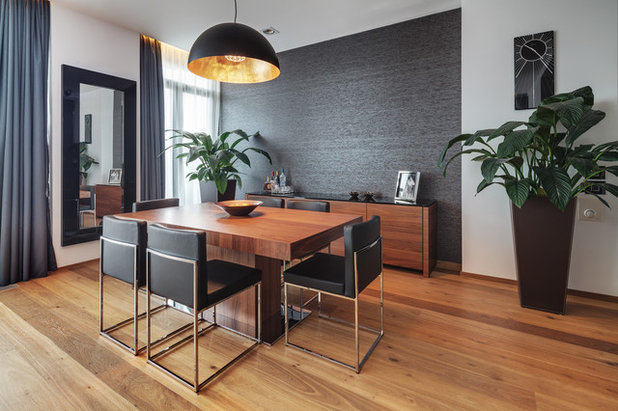By the time most houseplants show symptoms of neglect, it's already too late to save them. Not the peace lily (
spathyphyllum)
. You can revive a totally collapsed peace lily as if nothing happened. But that doesn't mean the plant looks rugged and tough. It blooms with beautiful white bract flowers in the spring. Plus, peace lilies thrive in low light, almost unheard of for blooming houseplants. And the peace lily made NASA's list of top-10 houseplants for efficiency in removing airborne toxins. Maybe it's time to give peace a chance.

D for Design
The peace lily's popularity is no accident. Caring for this plant is pretty straightforward, because it thrives in normal indoor temperatures, and when it needs water, it sags a bit, then revives quickly after being tended to.
Additionally, it's generally pest free, and it prefers light conditions that are on the dark side compared with many other houseplants, which also means it's a great plant for offices, bedrooms and hospital rooms. If that's not enough, it also blooms with lovely white bracts that last from a few weeks to two months in the spring. Well-cared-for plants may bloom again in the fall as well.
Note: Most peace lilies are sold when in bloom, and replicating the original blooms is slightly difficult. Many growers give their peace lilies a hormone called GA3 that is not readily available to the general public. Fertilize throughout the growing season and expect your blooms to be a bit smaller and possibly not as numerous.

studio1408
Extra-large versions of the peace lily look fantastic in high planters. But with leaves this size, you'll need to dedicate more time to dusting and maintaining the leaves.
The peace lily rids the air of the VOC benzene, a carcinogen found in paints, furniture wax and polishes. It also sucks up acetone, which is emitted by electronics, adhesives and certain cleaners.

KYZLINK
Peace lilies prefer shade with some indirect light. A spot 5 to 7 feet away from a south- or west-facing window should provide the right conditions.
Yellowing leaves, brown spots or streaks may be signs that the plant is getting too much light; if those occur, move your plant farther from the window or try a new, less-sunny location.
If the plant's leaves are still brown in the shade, they may need some misting. Peace lilies do well under fluorescent light without any sunlight at all, though generally they need 16 hours under the lights per day.

Terracotta Design Build
If you find your peace lily's leaves completely limp because you forgot to water for a while, don't despair — assuming the plant hasn't been slitting in its wilted state for days. Water and spritz right away, and your peace lily should revive within several hours.

ARTISSIMO - Idit Deutsch
Repotting. Repot your peace lily when the roots show or when it needs to be watered every few days. You should repot it every year or two at most, if at all.
To check for a severely root-bound pot, which would necessitate repotting, hold the plant sideways and slide the pot off to see if the roots are tightly packed together. If so, the plant could use fresh soil and more room. Peace lilies bloom better when somewhat root bound. So if blooms are a priority, repot only if the leaves turn yellow or the plant seems to need watering more than once a week.

John Lum Architecture, Inc. AIA
Peace lilies tend to have sensitive roots, so they are prone to root rot, generally a result of overwatering and poor drainage.
How to diagnose peace lily root rot. If your plant is wilted and watering does not revive it, or watering revives only some of the plant, it's very likely that root rot has set in. Depending on the state of the rot, you might be able to salvage the plant or part of it.
Immediately remove the plant from its pot and examine the roots. Cut away all roots that appear rotten or look dead otherwise. Wash old soil from the roots and repot the plant in potting mix made from equal parts soil, peat moss and sand. Review the watering needs of plant and hold off watering the newly repotted plant until the soil is dry.

Knudson Interiors
Propagating the peace lily. Since having more peace lilies means cleaner air, creating new plants is a good idea. And luckily the devision method is pretty easy. Separate the crowns, which are clusters of two or more leaves growing separately from the main plant, or hub, then repot. This process is most efficient when done during repotting in the spring. Here are the steps.
- Pull the pot from the plant and lay the bare plant flat on any surface outdoors, or on a piece of newspaper on a counter.
- Examine the plant to locate new crowns.
- Working from top to bottom, gently pry apart the roots that seem to belong to the crown. You will very likely break some roots in this process, which can take as long as 30 minutes. Some people prefer to take a chance and simply cut the roots down the middle between the plants.
- A young plant should be planted in a 6-inch pot, so the roots get the compact area they need.
- To minimize shock, use the same potting mix as you used in the original pot.
- Young plants may need staking and may wilt, but they should recover by the second week.
- The roots can be fragile, especially on young plants. Refrain from fertilizing for three months, because it can burn the tender new roots.

Possibilities for Design, Inc.
Unlike many houseplants, peace lilies do not enter a dormant stage during the winter. Therefore, while fertilizer isn’t necessary and water needs may be somewhat less in the winter, optimum peace lily care remains pretty much the same year round.
The standard peace lily can grow to 24 to 40 inches; deluxe plants can grow to 32 to 50 inches.
How to care for peace lily:Temperature: A consistent temperature between about 65 and 80 degrees Fahrenheit is ideal. Protect the plant from cold, drafts and drastic changes in temperature. It will not survive temperatures below 45 degrees.
Light: Prefers medium, indirect sunlight. A spot 6 to 8 feet away from a window helps keep light levels consistent as well. Yellow leaves indicate too much light. Brown spots and streaks indicate scorching from direct sun. Peace lilies do fine under fluorescent lights.
Water: Peace lilies like to be thoroughly watered but require good drainage and a chance to dry out between waterings. The plant will droop a bit when thirsty, telling you when it needs a drink. Pay attention to how many days it takes for your plant to start sagging, and plan to water one day prior. Watering about once a week and spraying leaves with water throughout the summer should keep your peace lily hydrated. Water less in winter. Peace lilies can be sensitive to chlorine, so if you want to pamper your plant, use chlorine-free water.
Drainage: Good drainage is highly important, because peace lilies are susceptible to root rot. Make sure the plant dries out between waterings and that the container itself has good drainage.
Soil: Use a standard houseplant potting soil. For best results use 50 percent Miracle Grow Moisture Control potting mix, 20 percent peat, 20 percent Perlite and 10 percent orchid potting medium, which contains charcoal.
Feeding: For the best blooms, feed monthly in spring and summer, preferably using an organic fertilizer (peace lilies are sensitive to chemical fertilizers) to help your plant bloom. If you choose to try a general houseplant fertilizer (20-20-20) use it at one-quarter of the recommended strength. Green blooms indicate overfertilization. Fertilize only when the soil is moist; fertilizer is unnecessary in the winter.





